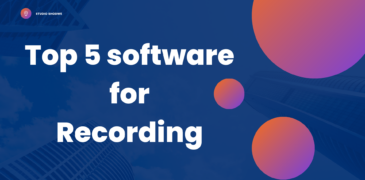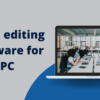Recording software empowers creators to capture and produce audio content with professional quality and efficiency. Among the top contenders, Audacity offers a user-friendly interface and a wide range of editing tools, ideal for beginners and seasoned professionals alike. Pro Tools stands out for its industry-standard recording and mixing capabilities, favored by audio engineers and music producers worldwide. Adobe Audition provides comprehensive audio editing features, seamlessly integrated with other Adobe Creative Cloud applications for enhanced workflow efficiency. Ableton Live offers a unique approach to recording and performance, with its innovative session view and real-time manipulation capabilities. Whether recording music, podcasts, or voiceovers, these software choices provide the tools and flexibility to bring creative visions to life with precision and clarity.
Top software for Recording are:
Audacity
Audacity is a powerful digital audio editor and recording application, offering a plethora of features for Windows, macOS, Linux, and other Unix-like operating systems. With over 114.2 million downloads since 2015, it’s a go-to choice for professionals and enthusiasts alike. Audacity’s non-destructive editing capabilities, including effects like normalization, trimming, and fading in and out, empower users to refine their audio with precision. Its ability to record multiple tracks simultaneously, schedule recordings, and utilize a punch in and roll fashion enhances workflow efficiency. With an intuitive interface and extensive documentation, Audacity remains a top choice for audio recording and post-processing needs, ensuring users can create high-quality audio content effortlessly.
Adobe Audition
Adobe Audition, developed by Adobe Inc., stands as a comprehensive digital audio workstation offering a versatile blend of features for both professional audio editing and multitrack mixing. Its roots trace back to Syntrillium Software, founded by former Microsoft employees Robert Ellison and David Johnston. Initially distributed as crippleware, Cool Edit evolved into Cool Edit Pro by 1999, receiving acclaim for its capabilities.
Cool Edit Pro introduced the groundbreaking ability to work with multiple tracks, a notable feature for audio professionals. While audio processing was initially destructive, later versions, particularly Cool Edit Pro v2, embraced real-time non-destructive processing, allowing for more dynamic and flexible editing. This version also expanded capabilities to include surround sound mixing and support for unlimited simultaneous tracks based on computer hardware constraints. Notable plugins like noise reduction and FFT equalization enriched the editing experience in Cool Edit 2000 and Pro. Adobe Audition inherits this legacy, providing a non-destructive mix/edit environment and a waveform editing view. With a user-friendly interface and powerful features, Adobe Audition caters to both novices and audio editing professionals, offering efficiency and precision in creating and refining audio content.
Ableton Live
Ableton Live, a digital audio workstation developed by the German company Ableton, stands out as a versatile platform for music creation and performance on both macOS and Windows. Unlike traditional sequencers, Live is uniquely designed to function as an instrument for live performances and a comprehensive tool for composing, recording, arranging, mixing, and mastering. This dual functionality makes it a favorite among musicians, producers, and DJs alike.
Live’s suite of controls facilitates seamless beatmatching, crossfading, and various effects crucial for turntablists, establishing it as one of the pioneers in automatically beatmatching songs. The software is available in three editions: Intro, Standard, and Suite, each catering to different user needs. Suite, the most feature-rich version, incorporates Max for Live functionality through a partnership with Cycling ’74, expanding creative possibilities.
Pro Tools
Pro Tools, developed by Avid Technology, stands as a prominent digital audio workstation (DAW) for music creation, sound design, audio post-production, and mixing on both Microsoft Windows and macOS. Functioning both as standalone software and in conjunction with external converters and PCIe cards, Pro Tools offers unparalleled flexibility in audio processing. The integration of on-board digital signal processors (DSP) enhances real-time effects, ensuring efficient processing of reverb, equalization, and compression with lower latency.
Pro Tools serves as a multifaceted tool, acting as a multitrack tape recorder, mixing console, and digital editing suite. It excels in non-linear and non-destructive editing, allowing users to manipulate audio without overwriting source files. The virtual mixer facilitates real-time adjustments to audio effects, virtual instruments, and hardware emulators. Pro Tools supports various audio bit depths, sample rates, and formats, accommodating a wide range of creative preferences.
GarageBand
GarageBand, an Apple software application available for macOS, iPadOS, and iOS devices. It has established itself as a user-friendly digital audio workstation (DAW) and music sequencer. Originally released in 2004 for macOS and expanded to iOS. In 2011, GarageBand caters to music and podcast creation, positioning itself for the consumer market.
GarageBand boasts a rich selection of virtual software instruments, including realistic sampled instruments and software-modeled synthesizers. Users can create original compositions or perform live using USB MIDI keyboards or the on-screen virtual keyboard. The synthesizers, categorized into virtual analog and digital, provide adjustable parameters for sound customization. Ensuring a broad spectrum of creative possibilities. With an array of preset effects and the option to create custom effects. GarageBand is a versatile and accessible tool for musicians, podcasters, and creators seeking an intuitive platform for music and audio production.
Conclusion
In conclusion, recording software plays a pivotal role in the modern landscape of music and audio creation. From industry-standard platforms like Pro Tools. It is offering comprehensive features for professionals, to user-friendly options like Audacity and GarageBand, catering to a broad spectrum of creators. These tools empower individuals to capture, edit, and produce high-quality audio content. The diverse range of software, whether geared towards live performances, intricate compositions, or seamless podcast production. This reflects the evolving needs of musicians, producers, and content creators. Recording software continues to be a catalyst for innovation, enabling users to transform their creative visions into immersive and impactful auditory experiences.







